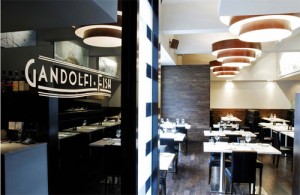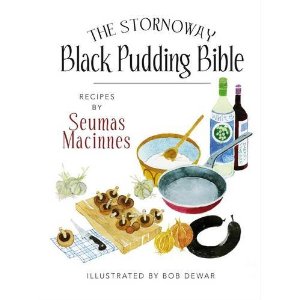 ][1]
][1]Raised in Glasgow but with a Hebridean background, Seumas MacInnes is the owner of Glasgow’s landmark Gandolfi restaurants in the Merchant city. The long established Cafe Gandolfi was joined by Bar Gandolfi eight years ago and then Gandolfi Fish in 2007. Last year, Seumas opened a pop-up champagne bar in Hutcheson’s Hall on Ingram Street. Gandolfi Goes Pop marked Cafe Gandolfi’s 30th birthday.
Seumas has two books in print: The Cafe Gandolfi Cookbook and The Stornoway Black Pudding Bible which was released at the end of September and is already on its second print run.
Cafe Gandolfi won the Lifetime Achievement award at the Glasgow Restaurant Awards a fortnight ago.
How long have you been at Cafe Gandolfi now?
SM: It was opened in 1979 by Iain MacKenzie, a photographer. He named it after the camera maker Louis Gandolfi. I was doing my hotel management degree at the time and I had an outside catering business but I wasn’t making any money. My sister was dating someone who worked at Cafe Gandolfi and they got me some shifts as a kitchen porter to help pay the rent. That was in 1983. It all went from there. I started working front of house, became manager and then a partner in the business. I bought the whole business in 1995.
What was the Merchant City like back in the early days?
SM: There was just nothing else here. The cheese market and the fruitmarket were in business from early morning and during the day but at night there was nothing. I think Babbity Bowsters was the next place that opened.
 ][5]
][5]A lot of restaurants don’t survive three years. Why is Gandolfi still around after thirty?
SM: I think that when Iain started the place, he insisted on good quality, seasonal food done simply. I don’t think that has changed. It’s always been about honesty, simplicity and seasonality. It’s the sort of food that I want to eat myself. It’s very fashionable now but it wasn’t when we started out.
At what point did the rest of the world come around to the Gandolfi way of thinking?
SM: I don’t think they have, have they?
Do you think Glasgow’s restaurant scene has changed dramatically in that time?
SM: It’s unrecognisable. There used to be all these grand old places like La Fourchette and Triangle which haven’t survived. I don’t know why. Recessions come and go. Sometimes restaurants just aren’t right for their times whether that’s because they are ahead or behind everyone else.
You’ve written a recipe book on the glories of Stornoway black pudding. Would that feature in your fantasy meal?
SM: No. Lobster and chips with home-made mayonnaise would be fine. In Nova Scotia, they cover the table with newspaper, tip all these lobsters on and just get cracking. It sounds great but their lobsters aren’t as good as the ones we get in Scotland. Cheaper but not as good.
Was it hard to find a publisher for a black pudding recipe book?
SM: Not at all. I’d self-published the Cafe Gandolfi book and Birlinn had distributed it for me. I was having lunch with them and they asked if I’d thought of writing another. I said I’d like to do one on Stornoway black pudding; they said yes and here we are. It’s already on its second print run. It’s very versatile stuff, black pudding.
Any kitchen disasters you would like to share?
SM: There have been so many after all these years. You quickly learn to forget about them and move on. Having said that, the time that the steam oven broke down and flooded Arta below us does stick in the mind.
Gandolfi Fish uses seafood supplied by your relatives and other fishermen on Barra. Is there a direct link between the dishes you serve in your restaurant and the food you ate as a child when you were on the island?
SM: Not really. That West Coast thing of boiling fish wouldn’t work very well in a restaurant. What we do here borrows from all over the place. British cooking was never that strict about where it came from and we pinch a few Italian and French influences. It’s still simple and honest though. I don’t want my food to look as though ten different chefs have had a go at it.
Who cooks at home?
SM: I do which may be a bit strange for someone who works in a restaurant. We have three children. The oldest is off to study but the twins are sixteen and still with us. I try to have as many family meals as possible. I’m a member of Slow Food and think that sitting down with your family to eat is important. The Slow Food concept is not about buying posh vegetables. It’s an attitude. It’s about taking time to enjoy and appreciate your food.
Any more expansion plans on the horizon?
SM: Never say never but I think I’m fine as I am just now. In the current climate you just don’t know what’s around the corner. I can control these three places and that’s how I like it. I’m very hands-on. I wouldn’t want to open in Edinburgh and then be driving back and forth all the time.
After more than a quarter of a century here, don’t you ever get itchy feet?
SM: When I started working here I used to dream of owning it and now I do. Sometimes, it still seems like a dream. I love working here. Recently, I gave a talk about competition. I said that I had no reason to fear other operators or big chains because nobody could love running these restaurants as much as I do.
And finally, what’s been your daftest customer complaint?
SM: There’s been a few but I did like the customer who came in and asked for a cappuccino but asked us to go easy on the ‘cino’.
 ][7]
][7]
